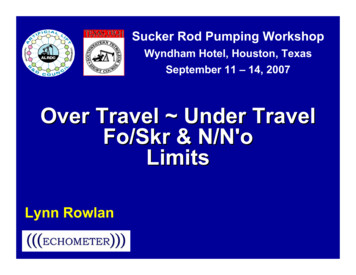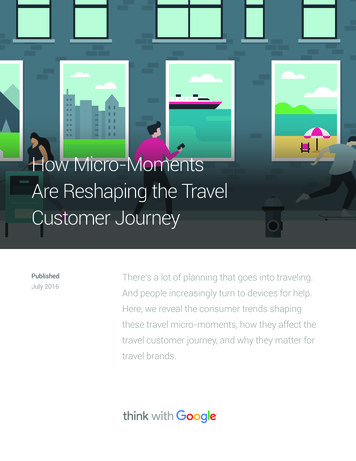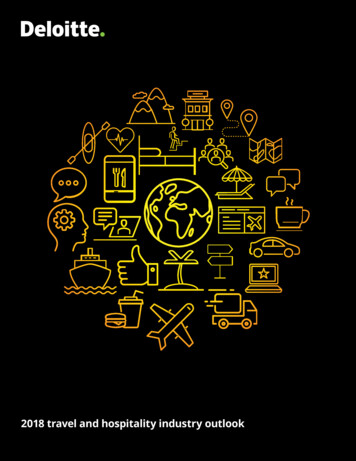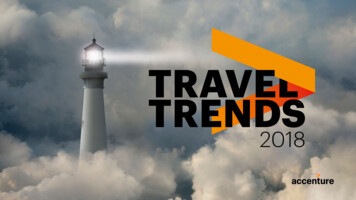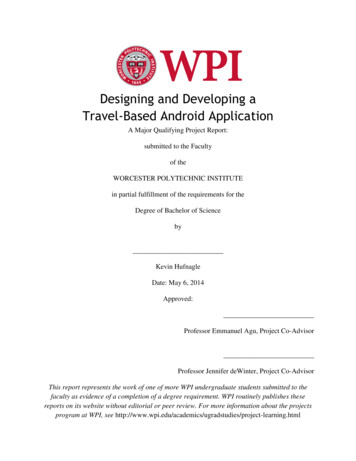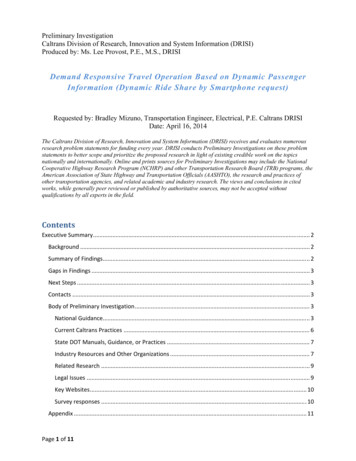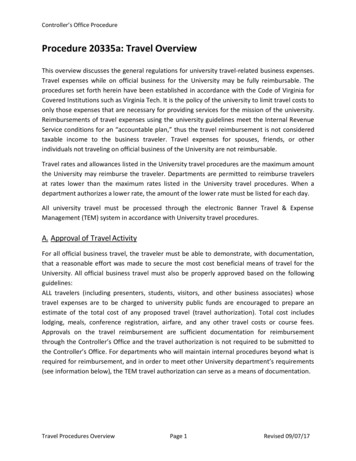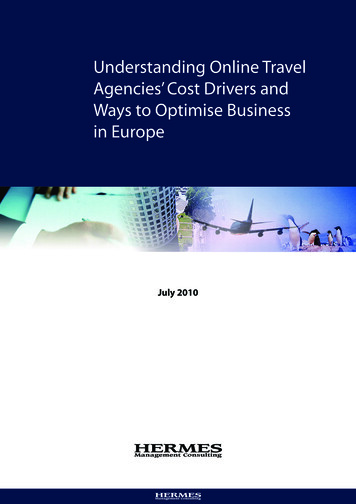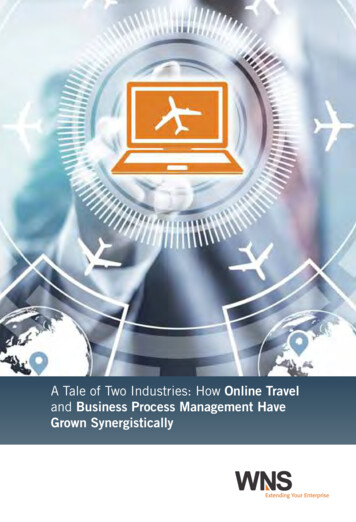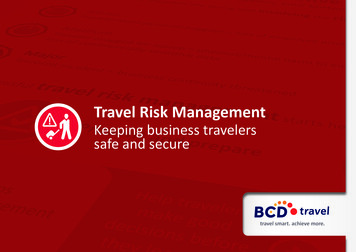
Transcription
Travel Risk ManagementKeeping business travelerssafe and secure
Travel Risk Management: Keeping business travelers safe and securePlease sit back, fasten yourseatbelt and read our pointof view and recommendationson Travel Risk Management.»Keeping business travelers safe and secure«2 2015 by BCD Travel. All rights reserved.
Travel Risk Management: Keeping business travelers safe and secureTravel Risk Management:Keeping business travelers safe and secureInfographic: Safe and productive . . . . . . . . . . . . . . . . . . . 4Executive summary . . . . . . . . . . . . . . . . . . . . . . . . . . 5Introduction . . . . . . . . . . . . . . . . . . . . . . . . . . . . . . 7Are you risk-managing your meetings? . . . . . . . . . . . . 7Why travel risk management has become even more important . 8ContentsManaging travel risk is a challenge . . . . . . . . . . . . . . . . . 11Manage risk proactively—not when it’s too late . . . . . . . . . 14Expatriate employees . . . . . . . . . . . . . . . . . . . . . 14Creating a TRM program . . . . . . . . . . . . . . . . . . . . . . 15How to win senior management buy-in . . . . . . . . . . . . 18Travelers employed by third parties . . . . . . . . . . . . . . 34Data security for travelers . . . . . . . . . . . . . . . . . . 48Your turn to manage travel risks . . . . . . . . . . . . . . . . . . . 53For more information . . . . . . . . . . . . . . . . . . . . . . . . 55Claudia Unger, Director of Research & Intelligence for BCD TravelClaudia leads a research team charged with identifying ideas that businesses can use to improve theirtravel programs. They take intriguing tactics and concepts that are being used outside our industry—and some that are way out on the frontier, like behavioral economics—and explore how to make themresonate in managed travel.3 2015 by BCD Travel. All rights reserved.
Travel Risk Management: Keeping business travelers safe and secureSafe and productiveFulfill your duty of care by protecting your travelers, your bottom line and your reputationKnowing the risks and impacts your travelers are facing and involving the right people will keep everyone safeMinorTraveler loses personal baggage loss of employee productivityRisksMedium Globalization Technology Accidents Natural events Public unrest/war ReputationTraveler mugged for laptop physical/mental harm to employee;loss of commercially sensitive dataMajorTerrorist incident business continuity threatenedSuccessful travelRisk assessment Incidents to date Destinationassessment Types of risk4 2015 by BCD Travel. All rights reserved.Draw on thevaluable insightsof experiencedtravel riskmanagementconsultantsStakeholders Human Resources IT Legal Security Senior management Suppliersrisk management starts here:Prevent and prepare Security tips Crisis management InsuranceHelp travelersmake gooddecisions beforethey leave andwhile en routeCommunicate and audit Get traveler buy-in Ask for feedback Reinforce importanceDemonstrate yourcommitment toyour employees’wellbeing
Travel Risk Management: Keeping business travelers safe and secureYour employees are at risk whenever they take a business trip: They stand out from the local population They often visit unfamiliar places Tiredness/jetlag may affect their judgment There are more/unknown health threats Driving, even to the airport, is always a riskIf one of your travelers is involved in a serious health, safety or security incident, yourcompany potentially faces several consequences, including: Legal FinancialExecutivesummary Damaged reputationAnd there are other threats to consider, including the loss of commercially sensitive data,and corruption and bribery.So it’s no surprise to find that travel managers give travel risk management (TRM) a highpriority in their travel program, sometimes even ahead of making cost savings.While the events of 9/11 promoted awareness of the importance of TRM, three recenttrends have enhanced its application: Globalization: Businesses are sending more travelers to more destinations, especially inemerging markets. More focus: Risk management has risen sharply up the agenda in corporate boardrooms. Legislation: Companies are feeling more pressure to do everything they reasonably can tolook after their employees.So how well are businesses risk-managing their travel? We surveyed 510 travel managersglobally in November 2014 and found a mixed picture.5 2015 by BCD Travel. All rights reserved.
Executive summaryTravel Risk Management: Keeping business travelers safe and secureThe good news is many companies are already using a wide range of TRM tools andprocesses. The bad news is there’s often no strategy to join all these tools andprocesses together.This lack of co-ordination is the dangerous fault line in TRM today: lots of good practices butno one co-ordinating and managing them. To create a reliable TRM strategy you need aroad-map, so we have created one for this white AuditGet the rightpeople involvedGet the right dataMap your risksMitigate your risksIntroduce theright tools andprocessesInform travelers,inform yourselfKeep the programalive and relevantThat’s our road-map. Now it’s time to take the journey. Please read on for much more detail.6 2015 by BCD Travel. All rights reserved.
Travel Risk Management: Keeping business travelers safe and secureIntroductionThe link between travel and riskTravel is a risky business. Wheneveremployees set foot outside their regularworkplace, their exposure to security,safety or medical problems increases.There are many reasons why, including: Business travelers usually stand outfrom the local population as different(and probably richer), making them atarget for criminals and terrorists. They may be visiting unfamiliar places. They are often tired and/or jetlagged. They face more health risks outsidetheir home environment. Flying and rail travel are relatively safe,but car travel (an element of mostbusiness trips) is not, especially if thetraveler is doing the driving.Hence there’s a good chance of an incidentoccurring during a trip. Examples includeunrest at a destination, mugging/theft, caraccidents, natural disasters and disease.7 2015 by BCD Travel. All rights reserved.Of course, the level of risk varies accordingto the trip, and the vast majority ofjourneys pass off incident-free. A day-tripfrom Munich to Brussels needs less riskmanagement than a tour of the oilfieldsof southern Iraq. But the reality is morecomplicated than that. No trip is totallyrisk-free; it’s easy for a traveler to becomecomplacent in familiar situations, suchas driving home from an overnight flight,and this makes them more vulnerable tounexpected incidents.So all travelers face risk when they travel,and this risk is shared by employers too. Ifemployees suffer injury or illness on a trip,the company could face legal and financialconsequences, damaging their reputation.And failing to look after employees is onlyone type of travel-related risk companiesneed to think about. Other, less obviousbut still damaging, potential challengesinclude: Loss of commercially sensitive data Misbehavior by traveling employees Corruption and briberyAre you risk-managingyour meetings?When companies think about theirtravel risk management (TRM),they usually focus on trips byindividual employees. But whatabout meetings and events? It’strue that companies don’t normallystage conferences or other groupactivities in the highest-risk countries,but that doesn’t mean their eventsare risk-free. Publicized high-profileevents such as sponsored sportstournaments, or annual generalmeetings, are known to carry risks,but even get-togethers such asglobal sales meetings can attractunwelcome attention and are notimmune to incidents. All need specificplans and briefing.
Travel Risk Management: Keeping business travelers safe and secureToday’s travel managers fully understand how important TRM is to their travel program,their travelers and their company. In fact, they rate traveler safety and security even moreimportantly than savings and cost control:Please rate the importance of each of the following program goals to your companyWhy travel riskmanagement hasbecome evenmore important100%90%80%70%60%50%40%30%20%10%0%Traveler safetyand securitySavings andcost control Not at all importantStandardsand efficiency LowTravelersatisfaction MediumEnvironmentaland social impact High(Source: Survey of 510 travel managers conducted by BCD Travel, November 2014)See the next page for several reasons why TRM has become a top priority for travel managers.8 2015 by BCD Travel. All rights reserved.
Why travel risk management has become even more importantGlobalizationGrowing focus on riskLegislationCompanies of all sizes are increasinglysending employees to more countries.Some are remote or high-risk destinations.And it’s getting more difficult to determinethe current level of risk for somecountries, particularly as this is growingeven in destinations previously regardedas low-risk.Management of all types of risk hasrisen sharply up the agenda in corporateboardrooms. Investment analysts nowassess listed companies formally onthe strength of their risk management.Many large organizations—and evensmaller ones—have created internalgroups to oversee their risk managementstrategies. Some have gone even furtherand appointed chief risk officers to takecharge of minimizing threats to all areas oftheir business.Companies are feeling greater legalpressure to do everything they reasonablycan to protect the health and safetyof employees. The United Kingdom’sCorporate Manslaughter and CorporateHomicide Act of 2007 (see next page)has been highly influential on corporatethinking about risk, but there are manyother examples of legislation in this area,particularly within the European Union.As a result, companies are aware they musttake preventative measures to ensure saferworking and know they are liable if theyhaven’t taken reasonable steps to do so.While it is encouraging that manycompanies look after their employees, it’sa serious concern that there’s still somethat aren’t doing enough. This needshighlighting, because companies canquickly find their finances and reputationsdamaged if they are judged to be negligentafter a major incident. But even if thereality is that these travelers’ employersdo have a robust TRM strategy, the poorperception could be hurting their ability toattract and keep good employees.9 Travel Risk Management: Keeping business travelers safe and secure 2015 by BCD Travel. All rights reserved.Put together, it means the bar for dutyof care has risen significantly over thepast decade. What was once consideredgood enough may not be good enoughany more. Is your company at the veryleast meeting today’s industry standardson care?
Why travel risk management has become even more importantTravel Risk Management: Keeping business travelers safe and secureRelevance to travel risk management The Act does not apply to deaths of employees outside the U.K. (unless they die onBritish-registered aircraft or ships), but it does apply to all work-related deaths in the U.K.even if the employing organization is registered in another country. The Act does not define a gross failure of management, and there is no specific referenceto travel. However, legal and security experts say the Act has three major implications forbusiness travel:The U.K. CorporateManslaughter andCorporate HomicideAct 2007This law, which came into effect in 2008,is considered to have raised the bar forduty of care towards employees not justin the UK but throughout the developedworld. Senior management may now beconsidered responsible for deaths causedby management failures that are judged tobe a gross breach of duty of care.Risk assessment – Organizations should carry out risk assessments for every journeyinvolving the U.K. For nearly all business trips, the assessment can be a simple,generic evaluation.Communication – Organizations must ensure their travelers have understood andacknowledged the duty of care responsibilities for themselves and their employers.Driving – Driving by employees is by far the greatest travel-related risk within theU.K., but it is an activity that often goes unmanaged. Consider reducing risk by, forexample, checking the documentation of drivers and their vehicles, and banningself-driving immediately after long-haul flights.InfluenceAs of March 2014, only six prosecutions had been concluded under the Act. However,corporate manslaughter cases are complex and slow, and there are many cases in thepipeline. A common theme in prosecutions so far has been a lack of risk assessments, orfailure to follow risk assessments, by the prosecuted company. All resulted in heavy fines forthe company.There are laws which treat corporate negligence as a crime in Canada, Norway, Finland,Denmark, the Netherlands, France, Germany and Australia. The U.K. Act, which came later,is considered to be tougher. So far, only one other country, New Zealand, is progressing asimilar bill, but the U.K. Act is influential in other ways: security experts say multinationalcompanies feel obliged to make duty of care in other countries consistent with what theyprovide in the U.K.10 2015 by BCD Travel. All rights reserved.
Travel Risk Management: Keeping business travelers safe and secureHow do you manage travel security and risk in your program?0%20%40%60%80%100%Enforce designated booking channelsManagingtravel risk isa challengeThe events of 9/11 acted as thecatalyst for introducing manystandard travel risk procedurestoday, such as systematic travelertracking (see page 42
Travel Risk Management: Keeping business travelers safe and secure. Your turn to manage travel risks. Introducing a TRM program reduces your company’s risk exposure; improves duty of care to travelers; and equips your company to expand globally. And you’ll be doing your best to
